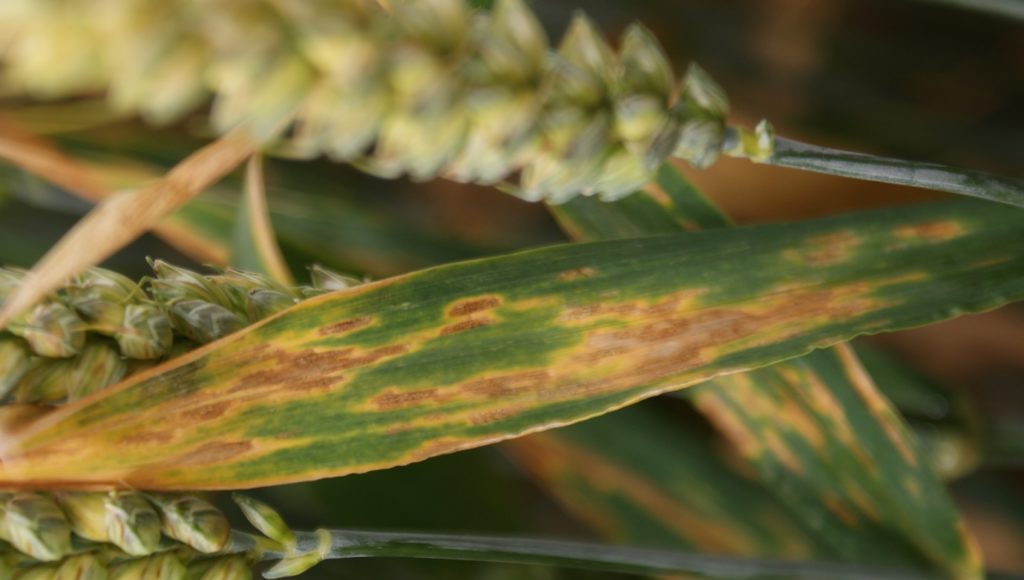The importance of protecting the flag leaf in winter wheat
26 April 2019The increasing challenge of achieving effective disease control in winter wheat has been generating much discussion, with concerns about declines in product efficacy and product withdrawals layered on top of the perennial challenges of getting spray timings precise in variable seasons and tight weather windows. The importance of the flag leaf in generating yield in wheat is without dispute. Wheat is source limited which means yield is driven by the amount of energy the upper leaves can capture through to harvest. This contrasts with barley which is sink limited where the number of grain sites laid down early in crop development limit yield. In wheat the flag leaf and the ear above it contribute 75% of the total final yield and in SRUC trials flag leaf sprays commonly contribute 60-70% of the yield attributes to a fungicide programme.
Much has been written and said about the importance of targeting leaf layers in wheat but the principles of this are well known to growers, who are getting rather tired of being told how to count to three leaves. That’s the easy bit, but nobody deliberately sets out to have a badly timed spray programme so it is probably more useful to consider what the trip points are, what’s changed in chemistry and how to best cope with differing scenarios.
The azole chemistry around which the wheat fungicide programmes are constructed is far less eradicant than it used to be. A decade ago we could get as much as week of kick-back from azole chemistry which meant that timings could be far less precise and leaves two and three could be left untreated for over a week with no particular consequences. Now, with declines in azole efficacy due to resistance, the kick-back of azoles has all but gone. The SDHIs, although with some eradicant activity, are broadly protectant in nature and shifts in septoria to this group of chemistry has chipped away at their efficacy too. And the multisites, of which chlorothalonil is the most effective, are entirely protectant in nature. This has all served to increase the exposure of leaf 2 to disease, and it not only contributes to yield but also allows easy transfer of disease to the flag.
Constructing programmes is based around knowing that leaf three has to be well protected just after emergence but also on the fact that spray intervals should ideally be not more than three weeks. This requires a degree of foresight as to when the flag leaf is likely to emerge. Anything over four weeks leaves the likelyhood that disease in leaf 2 will be too far advanced to manage well with the flag leaf spray.
Common scenarios which disrupt the best laid spray plans are T1 being applied early in order to cope with getting round a large acreage or getting on ahead of forecasted disruptive weather. Or the timing can be good but then the crop ‘slows’ down and the gap to flag leaf emergence ends up being too long. If the gap to the flag leaf spray (T2) is getting towards 4 weeks or more then options include upping the dose at flag leaf and / or the insertion of a T1.5 spray. This is never the ideal but can be necessary if things slip badly. Another reason for a T1.5 can be the appearance of yellow rust in the crop and where this won’t wait then azole and strobilurin chemistry can be effective.
Flag leaf sprays should be built around strong azole and SDHI options as balanced mixtures, and a multisites should be included to increase the efficacy of the spray programme and to help steward against resistance. This is going to be our last season with the most effective multisite chlorothalonil and will be the most commonly applied, although growers are also taking the chance to build up the experience of alternatives like folpet and mancozeb. Doses should be tuned field by field to the variety and the pressure in the crop but will commonly be higher than in previous years in recognition of the pressure and potential in crops, and of the declines in efficacy seen in fungicides.
Fiona Burnett, SRUC for the Farm Advisory Service
Sign up to the FAS newsletter
Receive updates on news, events and publications from Scotland’s Farm Advisory Service

